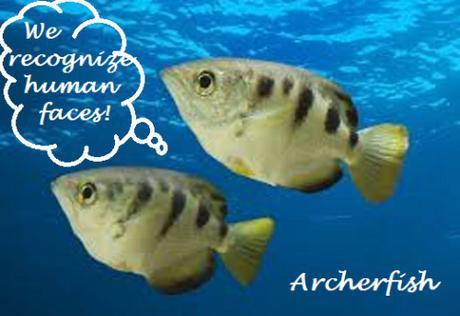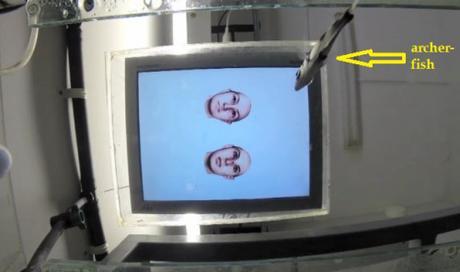A long-standing belief is that the ability to recognize and distinguish between/among human faces is possessed only by intelligent creatures like humans and primates because of their large and complex brains, specifically the visual or neocortex.
Then birds, who we now know possess neocortex-like brain structures, were discovered to also demonstrate human facial recognition.
But no one ever thought that fish, whose teeny simple brains don’t have a neocortex, would have that ability.
Now a new study shows that isn’t true. It turns out that fish, at least a species of tropical fish called archerfish, which lack the sophisticated visual cortex of primates, are nevertheless capable of not just recognizing human faces, but discriminating one face from up to 44 new faces!

Phys.org reports, June 7, 2016, that research carried out by a team of scientists from the University of Oxford (UK) and the University of Queensland (Australia) found that archerfish are able to learn and recognize faces with a high degree of accuracy—an impressive feat, given this task requires sophisticated visual recognition capabilities.
The study is published in the journal Scientific Reports.
Leading author Dr. Cait Newport of the Department of Zoology at Oxford University, said:
“Being able to distinguish between a large number of human faces is a surprisingly difficult task, mainly due to the fact that all human faces share the same basic features. All faces have two eyes above a nose and mouth, therefore to tell people apart we must be able to identify subtle differences in their features. If you consider the similarities in appearance between some family members, this task can be very difficult indeed.
It has been hypothesized that this task is so difficult that it can only be accomplished by primates, which have a large and complex brain. The fact that the human brain has a specialized region used for recognizing human faces suggests that there may be something special about faces themselves. To test this idea, we wanted to determine if another animal with a smaller and simpler brain, and with no evolutionary need to recognize human faces, was still able to do so.
Fish have a simpler brain than humans and entirely lack the section of the brain that humans use for recognizing faces. Despite this, many fish demonstrate impressive visual behaviours and therefore make the perfect subjects to test whether simple brains can complete complicated tasks.”

Archerfish shoots jet at insect
In the study, archerfish — well known for its ability to spit jets of water to knock down aerial prey — were presented with two images of human faces and trained to choose one of them using their jets. Dr. Newport explains:
“Archerfish are a species of tropical freshwater fish that spit a jet of water from their mouth to knock down insects in branches above the water. We positioned a computer monitor that showed images of human faces above the aquariums and trained them to spit at a particular face. Once the fish had learned to recognize a face, we then showed them the same face, as well as a series of new ones.”
 The result:
The result:
Presented with the learned face and a series of new faces, the archerfish were able to correctly choose the face they had initially learned to recognize.
The fish were able to choose the “correct” face even when more obvious features, such as head shape and color, were removed from the images. As described by Dr. Newport:
“In all cases, the fish continued to spit at the face they had been trained to recognize, proving that they were capable of telling the two apart. Even when we did this with faces that were potentially more difficult because they were in black and white and the head shape was standardized, the fish were still capable of finding the face they were trained to recognize.”
Not only that, but the archerfish were highly accurate when selecting the correct face:
- In the first experiment, the fish attained an average peak performance of 81% accuracy picking the previously learned face from 44 new faces.
- In the second experiment, the fish attained an even more impressive 86% accuracy even when distinguishing facial features such as head shape and color were removed.
Dr. Newport concludes:
“The fact that archerfish can learn this task suggests that complicated brains are not necessarily needed to recognize human faces. Humans may have special facial recognition brain structures so that they can process a large number of faces very quickly or under a wide range of viewing conditions.”
Newport and the other researchers are puzzled by the archerfish’s ability to recognize human faces not just because the fish don’t have humans’ neocortex, they don’t have the evolutionary need to recognize human faces.
Which, of course, leaves Creation as the answer. 😀
 ~Eowyn
~Eowyn

